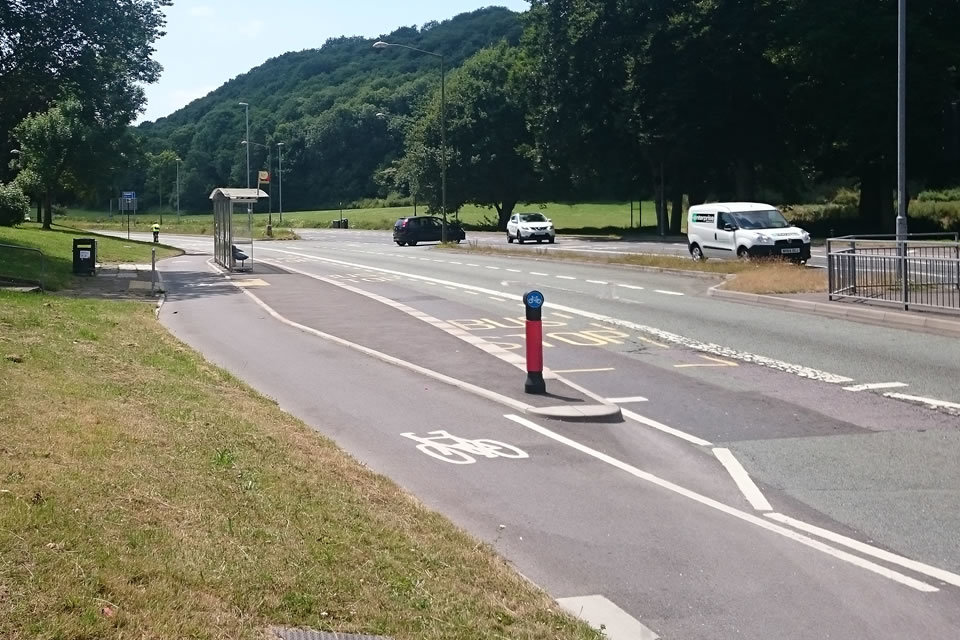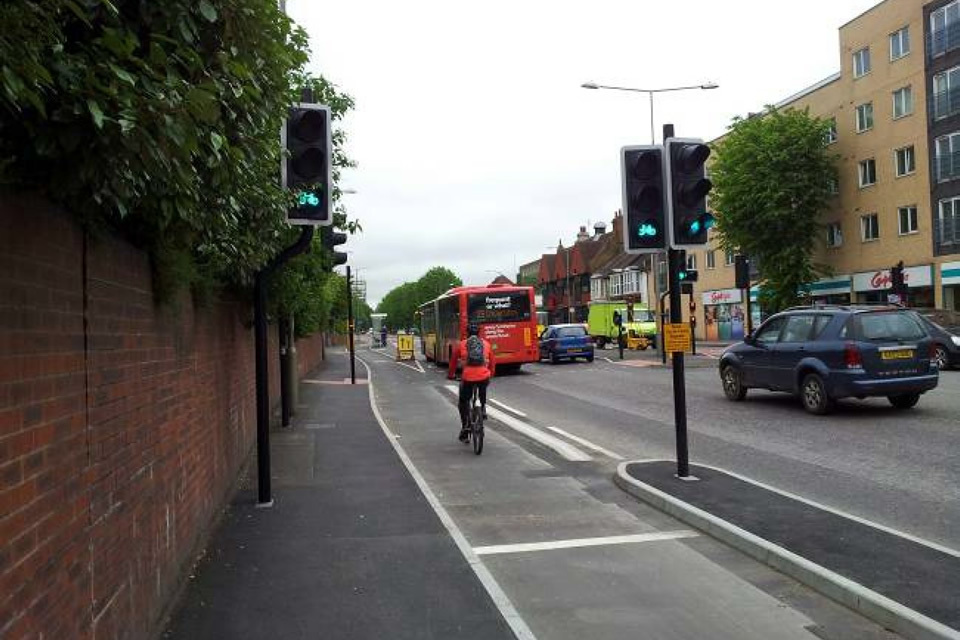Improving Lewes Road in Brighton for buses, cyclists and pedestrians
The reasons Brighton and Hove council turned a lane on Lewes Road into a bus and continuous cycle lane, and the results of the work.

Bus stop bypass on Lewes Road, Brighton showing the cycle path deflection and the bus passenger crossing point.
What we did
Brighton and Hove council reallocated an entire lane of Lewes Road in each direction from general traffic into a bus and cycle lane. Lewes Road is a busy 4.5km dual carriageway carrying 25,000 vehicles per day. It has been transformed into a rapid transit style bus and cycle corridor.
The £1.4 million scheme includes innovative features to maintain continuity for cyclists, such as a dedicated cycle bypass at traffic lights, an early start signal for cyclists and ‘floating’ bus stops where cyclists can pass behind bus stops with no interference from stopping buses.

Bus stop bypass on Lewes Road on the approach to Brighton from the north.
A key feature is the 14 ‘floating’ bus stops, which remove the conflict between buses and cyclists, seen as a significant barrier to cycling in this location. The bus shelters located on the island are the first of their kind in the UK.
Why we did it
Lewes Road (A270) is an important part of the city’s road network, linking the city centre northwards to major employers and destinations, including 2 universities, a medical school and a football stadium. The scheme aimed to:
- encourage greater use of more sustainable forms of travel
- reduce the speed and volume of traffic using Lewes Road
- reduce the severity and number of accidents
- provide additional safe crossing places for pedestrians and cyclists
Post-scheme monitoring reveals shifts towards cycling along the corridor, demonstrating that the infrastructure improvements have encouraged people to travel differently. Traffic surveys undertaken before scheme construction were replicated shortly after the scheme opening in September 2013 and again in February 2015.

One of the Lewes Road junctions in Brighton before the improvements.
How we did it
The individual measures formed part of an overall corridor improvement scheme providing 2 metre wide cycle lanes and 3 metre wide bus lanes along Lewes Road. The bus stop bypasses were provided by reallocating road or verge space. The cycle lanes and the segregated cycle track that allows outbound cyclists to bypass red traffic signals at the junction with Coombe Road were achieved by reallocating road space.
We held public exhibitions at 10 locations in the Lewes Road area. We used the information we gathered at these roadshows to help inform the nature of the works carried out in the area. A questionnaire was available for attendees to complete at the exhibitions and online. Council officers also attended several Local Action Team and other community group meetings as part of the consultation.
We received over 550 responses. Most people said their journey along Lewes Road was ‘predominantly poor’ or ‘very poor’, whereas only 24% felt it was ‘good’ or ‘very good’. The most common transport problems in the area were traffic congestion, inconsiderately parked vehicles and a perception that it was unsafe to cycle. The most commonly requested transport improvements were cycling improvements and improved traffic flow.
There was extensive dialogue with Brighton and Hove Bus Company, who were one of the partners in the project delivery team. This team met regularly and agreed design details through discussion.
What we learned
Since their introduction on Lewes Road, the ‘floating’ bus stops have generated considerable interest in the cycling world. They have been visited by Transport for London and numerous other local authorities, many of whom now have similar plans for their areas.
The design of the bus stops was carefully considered to ensure that it was cost effective and could be replicated at all bus stops along the route. In particular, the layout has been fully accommodated within the existing footprint of the previous bus stop layby, minimising implementation costs and timescales.
More recently, major improvements to the Vogue Gyratory (located on the same corridor immediately south of the original scheme) built on this experience. They introduced a further ‘floating’ bus stop within a highly complex junction layout with high pedestrian, cyclist and vehicular flows. The improvements were made in 2014 and have so far proved very successful and popular, particularly with cyclists.
The most recent monitoring revealed:
- daily cyclists on Lewes Road have increased from 2,085 to 2,806 following scheme implementation – a 34% increase
- 7% increase in bus passengers from 15.3 to 16.4 million (2012-2013)
- improved bus journey times in both directions
- general traffic has reduced by 17% with no evidence of displacement to alternative routes
- journey times for general traffic on Lewes Road have reduced in both the morning and inter peak periods
- journey times in the afternoon have increased, however this falls within anticipated changes predicted at scheme design stage
- queue lengths on side roads joining Lewes Road have generally not increased

Cycleway bypass of a traffic signalled road junction on Lewes Road, Brighton.
We have compared accident statistics for 2009 to 2011 (before the scheme) to 2014, the first year after the start of scheme. The figures show:
- a 50% reduction in the number of people killed or seriously injured along this section - average of 6.3 per year to 3 per year
- an overall increase in the number of cycle casualties - from an average of 8.6 per year to 15 per year, though an increase may be expected where there are more people cycling
- the severity of accidents has reduced significantly - all cycle casualties in 2014 were considered ‘slight’ whereas in the previous 3 years there had been 1 fatality, 8 seriously injured and 17 slight injuries
- no child casualties compared with an average of 3.3 per year in the previous 3 years, which included 2 serious injuries
Contact and further information
For more information: